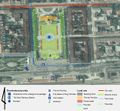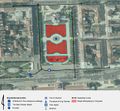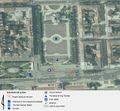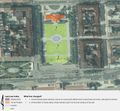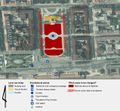Planting Design 2013 Working Group 19 - Case Study A
---> back to group page working group 19
King Tomislav Square
| Name | King Tomislav Square | |
| Location | Zagreb | |
| Country | Croatia | |
| Authors | Ana Žmire | |
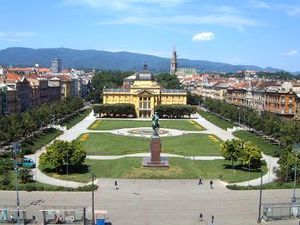
| ||
|
| ||
Rationale: Why is this case interesting?
King Tomislav Square is part of the famous "Lenuci's horseshoe" and one of the Zagreb's main symbol. Central area of the city of Zagreb was planned and built as a part of urban vision, that included a green frame (seven squares and the Botanical garden) shaped as an angular letter U or popularly called the "green horseshoe".
King Tomislav Square is still one of the most representative places in Zagreb that greets travelers coming into the city by train, and in some way represents a watershed between the old and the new part of the Lower Town, which extends south of the railway. It is a very important piece of Zagreb's garden heritage, and as such it serves many different purposes like exhibitions, different fairs, as a place of mass gatherings, concerts and such, and with a beautiful view of the statue of King Tomislav, the Art Pavilion and the Cathedral in the background.
For me it is a very important pedestrian green link on my way to the center of the city.
Author's perspective
One of my main duties as a landscape architect is to research and advise on the planning, design and management of open spaces and the environment, both inside and outside the built environment, and caring for its protection and sustainable development. Planning, design and management serve as a tool to build, maintain, preserve and improve places so they could be functional, beautiful, sustainable and appropriate for a variety of human and ecological needs.
Lenuci's horseshoe is a forgotten place on a very important location in Zagreb's urban matrix. Its role needs to be recognized and improved accordingly. King Tomislav square is the first thing that people who arrive to Zagreb by train see when they come out of the Main Railway Station building. At this point King Tomislav square is nothng more than a meadow with a few flowerbeds, when it should be something glamurous and amazing, not only because of the tourists, but also because of the citizens of Zagreb who pass by everyday on they way to the city center.
Landscape and/or urban context of your case
Parks of the Lenuci's horseshoe are located at the northern edge of the river Sava valley, which touches the slopes of Medvednica . In the past, the valley was covered with oak and hornbeam forest. Relief is flat and at the average hight of 115 meters above see level. Geology consists of gravel and sand from the river basin. King Tomislav Square is located in it's right, the eastern side.
Austrian emperor and Croatian king Franz Joseph I visited Zagreb in October 1895. For that occasion, in his tribute, the square that stretches between the Art Pavilion on the north side and the Main Railway Station in the south, was named after him - Franz Joseph Square. Park on the King Tomislav Square, with the surface of 3.5 ha was shaped in 1905/1906. It is located on the north side of the Main Railway Station. According to the plans of that time dent field was supposed to be filled and leveled with its surroundings, but because of the financial savings park kept its concave shape until today. In 1927, after the collapse of the Austro – Hungarian Empire it was renamed as King Tomislav Square, and the monument of King Tomislav, made by Robert Frangeš Mihanović, was placed on the square in 1947.
The northern side of the square is dominated by the building of the Art Pavilion, and the park itself, with a central fountain that lays south of it. The building is the oldest exhibition space in the region. It was designed for the Millennium Exhibition in Budapest in 1896 as the Croatian exhibition pavilion. The iron structure of the building was transferred to Zagreb, and in 1897 the project of reassembling, building walls and adjustments to the Zagreb's terrain was entrusted to Viennese architects Hermann Helmer and Ferdinand Fellner, while the construction was performed by Zagreb's builder Leo Hoenigsberg and Juliet Deutch. The Art Pavilion in Zagreb was officially opened in 1898 with a representative exhibition The Croatian Salon.
Opposite of the south side of the square extends the Main Railway Station building, that was built and opened for traffic in 1891/1892, and it's official title was the Station of the Royal Hungarian State Railways. It was designed by architect Ferenc Pfaff. Palaces designed by distinguished architects in Zagreb are situated on the east and west side. On the west border is Ante Starčević Square and the pedestrian underground passage that goes under the railway, which has been established as the link to the new part of the city that spreads south of the tracks. Streets that are located west and east of the square set up a link with those parts of the city, so that King Tomislav's Square represents a significant road junction.
Analytical drawings
- widths="150px"
What has changed? - The biggest change was the placement of the statue of King Tomislav and removal of the main entrance that used to be at that place. When it comes to the variety of plants that was planted here long time ago it is because of neglect, and simplifying things for lesser cost of maintainance.
Projective drawings
- widths="150px"
Summary and conclusion
During the past 100 years a few things have changed on the King Tomislav Square, its name, main entrance was replaced with a statue of King Tomislav and variety of plants have perished. Before the 2nd World War it was a representative place with lots of different plant species, annuals, perennials, shrubs, trees and ornaments from sand.
Since it is situated on a very important place when it come to tourism its glory needs to be returned. Boring geometrical flower beds should be converted into ornamental with a variety of perennials, like roses and shrubs, with ornaments of sand and gravel between them. This change would also be good from the financial point of view, increased cost at the beginning would pay of through years, because now plants are beeing replaced several times a year.
Today people just pass through because there is nothing interesting to attract their attention and interest them to stay for a bit. By increasing its dynamics through plants, very important biodiversity would be achieved, most importantly since this is one of the few green surfaces in dense city centre urban matrix. Not only would this change attract insects and other animals, but would also give people a place to take a walk, sit on a bench or lay on the grass, a place to rest while waiting for a tram or a train. When it comes to improving planting design on the King Tomislav Square it should be a wider mission, improving the „green horseshoe“ and giving it back its glory and main purpose, a place for the people.
Image Gallery
- widths="150px"
References
1. Knežević S., (1994). Lenuci i "Lenucijeva potkova" [1]
2. Karavla J., (2006). Dendrološke karakteristike zelene potkove grada Zagreba s prijedlogom obnove njezinoga istočnog dijela [2]
3. Žunić A., Matuhina N., (2012). Povijesni trgovi grada Zagreba nastali do 1918.; Prostorna geneza i urbanističke odlike [3]
4. Vuk J., (2004). Zagrebačka (geodetska) zelena potkova [4]
About categories: You can add more categories with this tag: "", add your categories

